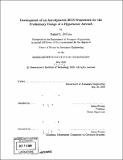| dc.contributor.advisor | Jaime Peraire. | en_US |
| dc.contributor.author | Dicara, Daniel L | en_US |
| dc.contributor.other | Massachusetts Institute of Technology. Dept. of Aeronautics and Astronautics. | en_US |
| dc.date.accessioned | 2009-08-26T16:53:32Z | |
| dc.date.available | 2009-08-26T16:53:32Z | |
| dc.date.copyright | 2006 | en_US |
| dc.date.issued | 2006 | en_US |
| dc.identifier.uri | http://hdl.handle.net/1721.1/46570 | |
| dc.description | Thesis (S.M.)--Massachusetts Institute of Technology, Dept. of Aeronautics and Astronautics, 2006. | en_US |
| dc.description | Includes bibliographical references (p. 59-60). | en_US |
| dc.description.abstract | The design of hypersonic airbreathing aircraft pushes the envelope of current state-ofthe-art aerospace propulsion and materials technology. Therefore, these aircraft are highly integrated to produce adequate thrust, reduce drag, and limit surface heating. Consequently, every aircraft component (e.g., wings, fuselage, propulsion system) is sensitive to changes in every other component. Including Radar Cross Section (RCS) considerations further complicates matters. During preliminary design, this requires the rapid analysis of different aircraft configurations to investigate component interactions and determine performance trends. This thesis presents a framework and accompanying software for performing such an analysis. The intent is to optimize a hypersonic airbreathing aircraft design in terms of aerodynamic performance and RCS. Computational Fluid Dynamics (CFD) and Computational Electromagnetics (CEM) are the two main framework software components. CFD simulates airflow around the aircraft to analyze its aerodynamic performance. Alternately, CEM simulates the electromagnetic signature of the aircraft to predict its RCS. The framework begins with the generation of a three-dimensional computer aided design aircraft model. Next, a grid generator discretizes this model. The flow simulation is performed on this grid and the aircraft's aerodynamic characteristics are determined. Flow visualization aids this determination. Then, aircraft geometry refinements are made to improve aerodynamic performance. Afterward, CEM is performed on aerodynamically favorable designs at various aspect angles and frequencies. RCS values are determined and used to rank the different configurations. Also, inverse synthetic aperture radar images are generated to locate major scattering centers and aid the design refinement. The design loop continues in this fashion until an acceptable aircraft design is achieved. The NASA X-43A test vehicle was used to validate this preliminary design framework. | en_US |
| dc.description.statementofresponsibility | by Daniel L. DiCara. | en_US |
| dc.format.extent | 60 p. | en_US |
| dc.language.iso | eng | en_US |
| dc.publisher | Massachusetts Institute of Technology | en_US |
| dc.rights | M.I.T. theses are protected by
copyright. They may be viewed from this source for any purpose, but
reproduction or distribution in any format is prohibited without written
permission. See provided URL for inquiries about permission. | en_US |
| dc.rights.uri | http://dspace.mit.edu/handle/1721.1/7582 | en_US |
| dc.subject | Aeronautics and Astronautics. | en_US |
| dc.title | Development of an aerodynamic/RCS framework for the preliminary design of a hypersonic aircraft | en_US |
| dc.title.alternative | Development of an aerodynamic/Radar Cross Section framework for the preliminary design of a hypersonic aircraft | en_US |
| dc.type | Thesis | en_US |
| dc.description.degree | S.M. | en_US |
| dc.contributor.department | Massachusetts Institute of Technology. Department of Aeronautics and Astronautics | |
| dc.identifier.oclc | 422598601 | en_US |
